There are two different approaches to mergers and acquisitions, according to Chris Anderson, CEO of Boston-based HPG, which has been aggressively scooping up fellow suppliers, such as Handstands, Origaudio, Debco and Webb Company, which has rebranded to Mixie.
“You can buy whatever comes your way if it means adding to your scale, but I call growth like that a tumor,” Anderson says. “It’s growing, but without any sort of purpose or predefined shape. Alternatively, if you have a well-laid out architecture that from the very beginning stipulates not only what you’re looking for, but also what you’re seeming to avoid, it makes it all the easier to strike quickly and with deep conviction when you see an opportunity that fits within that architecture.”
From mid-2021 through mid-2022, HPG – ranked the No. 8 supplier in this year’s PPAI 100 – was given the opportunity to look at more than 30 businesses, Anderson says. Ultimately, it didn’t acquire a single one.
“When you have discipline around the architecture, it makes it easy to say that even though I like the size of the business, it doesn’t meet with this strategic objective we’re trying to fulfill or doesn’t check off the box our board has given us a clear mandate on,” Anderson says.
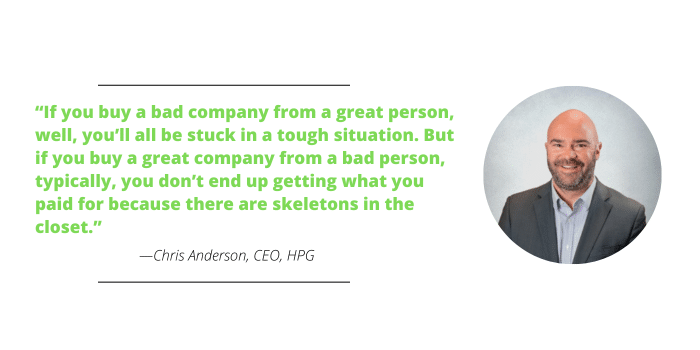
- HPG’s board of directors had asked Anderson what he was going to do to decrease the company’s reliance on Chinese imports. With manufacturing facilities in Southern California and Nogales, Mexico, Evans provided a solution.
- Plus, the supplier’s focus on tote bags, water bottles and other daily use items meshed well with HPG’s product strategy.
Perhaps most important was the cultural fit: Alan Vaught, co-founder and then-president of Evans, passed Anderson’s “barbecue test,” meaning he was like the guy down the street you’d want to hang out with.
“It was immediately clear that Alan built a great business and that he’s a high-caliber individual,” Anderson says. “At HPG, we’ve learned that you better check both of those boxes. If you buy a bad company from a great person, well, you’ll all be stuck in a tough situation. But if you buy a great company from a bad person, typically, you don’t end up getting what you paid for because there are skeletons in the closet.”
Approaching retirement age and with no plans for either of his children to take over, Vaught had begun considering his options. Initially looking for expansion capital, he talked to private equity firms who were interested in acquiring a larger percentage of the company than he had planned to give up. Then, after receiving offers from fellow firms in the promotional products industry, he landed on HPG.
“My wife and I met Chris and we really hit it off,” Vaught says. “As a seller, you want someone who’s had recent success with companies similar to our size and who are in a similar space. We had a huge level of trust in their team. As we got to know them better, we realized they looked at things similarly to the way we do.”
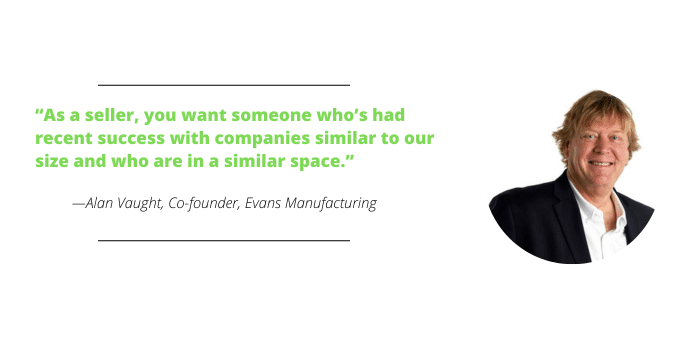
“The key to any good communication strategy is to plan it in advance and start with those who would be most impacted, having one-on-one conversations with the senior leadership team,” Anderson says. “If you do things in the right order, when a customer hears about it and calls their point of contact at HPG, they’re speaking to someone who doesn’t say, ‘I don’t know. I just read the release myself.’”
As part of the transaction, Vaught continued to lead Evans as division president until retiring last month. “The acquisition cleaned up a lot quicker than I had thought it would,” Vaught says. “My exit was planned, but it was just a matter of how long it would take. But their team is good. It didn’t take long to realize I could still be involved at some level, but I wasn’t needed at the day-to-day level that I was previously at.”
Vaught, who remains a significant HPG shareholder, has shifted from the “father of Evans” to now being the “cool uncle,” Anderson says. “He’s still very much in the family, and his advice and presence are value added, but in this case, if he decides to go on vacation for two weeks, it’s not disruptive, which is a testament to the depth of the HPG team and the business he created. This was a marriage of two strong and profitable enterprises.”
“My number-one rule is if the business is doing well, let’s not fix what isn’t broken,” Anderson adds.
True Partnership
While HPG has been spearheading rampant M&A activity on the supplier side, HALO, promo’s second leading distributor in this year’s PPAI 100, has been a major catalyst for consolidation on the distributor side.
The Sterling, Illinois-based juggernaut has welcomed several large distributors into the fold, such as Axis Promotions, Sunrise Identity and Caliendo Savio Enterprises (CSE). Last year, San Jose, California-based distributor BrandVia joined the list of high-profile acquisitions by HALO.
BrandVia President Jim Childers credits long-time friends Mitch Mounger, former president of Sunrise and current president of enterprise sales at HALO, and Larry Cohen, former president of Axis and current senior vice president of business development at HALO, for influencing his decision and introducing him to HALO CEO Marc Simon.
“We looked for a partner whose goals, values and culture aligned with ours,” Childers says. “I was a great admirer of Marc and what he has built at HALO.”
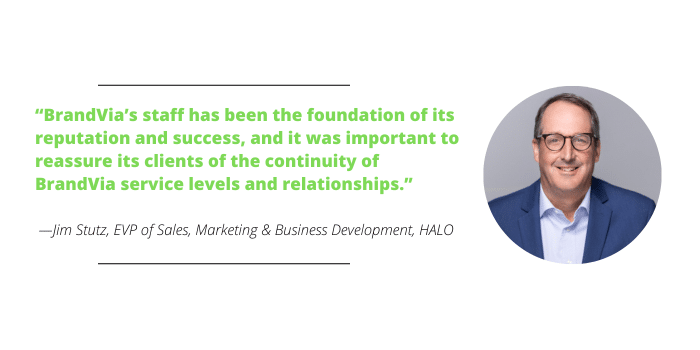
“BrandVia’s staff has been the foundation of its reputation and success, and it was important to reassure its clients of the continuity of BrandVia service levels and relationships,” Stutz says.
“Jim Childers communicated to clients that nothing is changing except where more and better could be offered – same sales teams, solutions, program managers, etc. He articulated that this was an opportunity to preserve the same level of client service they had come to expect, and that by combining with HALO, they would have access to even more solutions and capabilities.”
Both executives attribute the successful acquisition to viewing it as a true partnership and a chance to learn best practices from each other.
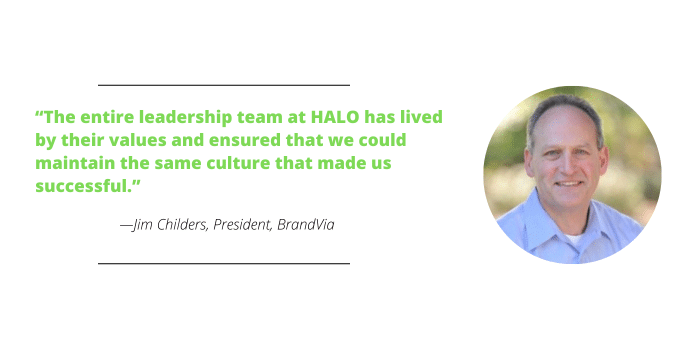
Rocky Start
Of course, not every transition is seamless.
Just ask Brandon Mackay, CEO and president of SnugZ USA – ranked the No. 9 supplier in the PPAI 100. In the aftermath of its January 2022 acquisition of fellow supplier Sweda, SnugZ faced mounting complaints, including online chatter about inconsistent service, from distributor customers.
“The transition was hard, and we were trying to be very open and forthright,” Mackay says. “Sweda is massive. It took 10 months to fully integrate the two businesses.”
Sweda’s investment banker initiated the discussion with SnugZ, which gets pitched deals “weekly,” Mackay says. Intrigued by Sweda’s vast array of product segments and California presence, SnugZ’s senior leadership team pursued a deal. Unfortunately, that meant some job losses on both sides of the equation.
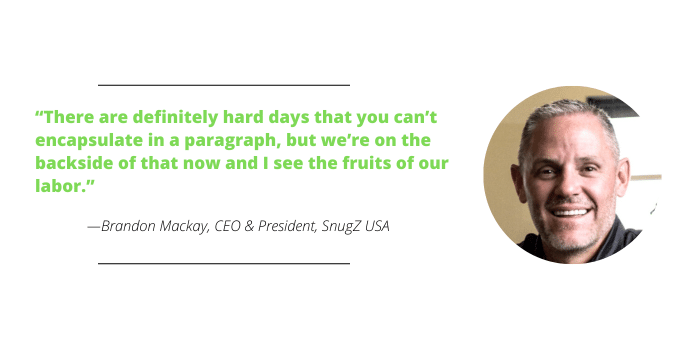
“Anytime you get acquired,” Mackay adds, “it’s very uncomfortable and scary. We just tried to tackle that head on by being present, meeting with people, going through their concerns and doubts, reinforcing what the overall strategy is and just trying to build comfort.”
Earlier this year, SnugZ acknowledged the criticism and announced several adjustments made to reduce lead times and improve service issues:
- Upgraded phone systems
- Hiring 20 new customer service representatives
- Bringing in “a hundred truckloads” of inventory and equipment to its Utah and Texas FOB facilities
- Adding hundreds of items to inventory, including retail brands
- Completely integrated systems and websites
“I’m excited for our future,” Mackay says. “Obviously, I’m very bullish on it. Of course, there are moments of doubt, where you’re like ‘holy crap, I wish we hadn’t done this.’ There are definitely hard days that you can’t encapsulate in a paragraph, but we’re on the backside of that now and I see the fruits of our labor.”
Preserving The Family Legacy
When Rosalind Plummer passed away from an aneurism in 2017, her husband David and daughter Kate decided it was time to sell the family business.
After nearly 30 years at the helm of Canadian supplier Clearmount, which has earned a stellar reputation for premier customized awards, David, MAS, was ready to retire. And with Kate, vice president of sales and marketing, having no intention of taking over, they put feelers out to see if any promotional products firms were interested in an acquisition. Although fellow Canadian supplier St Regis Group made an offer, Kate says it wasn’t the right fit at the time.
“I decided to just grow the company and then revisit a sale in a couple years,” Plummer says. “I grew Clearmount by growing my own brand. I volunteered for everything and went to every networking opportunity. My plan was to get to know people and then they’ll get to know Clearmount and we’ll grow.”
While Plummer continued to make a name for herself in the industry, she also prepared for a sale. To determine the value of the business and Clearmount’s position in the marketplace, she relied upon EBITDA (earnings before interest, taxes, depreciation and amortization). Then, she evaluated every aspect of the company, from the technology used to the training methods of salespeople and production staff, aiming to improve efficiency.
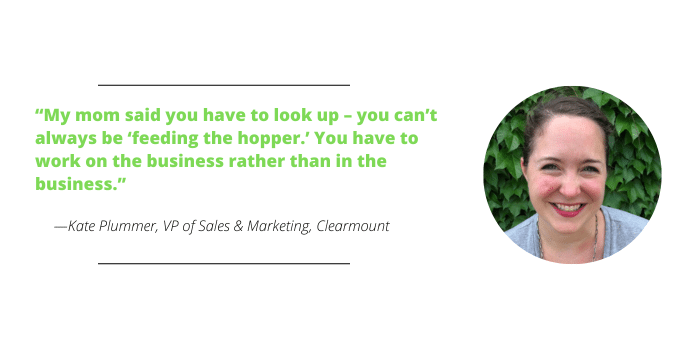
During this process, her father was diagnosed with pancreatic cancer. As a result, he left the sale in his daughter’s hands. “Contrary to popular belief, the acquisition didn’t happen because of the diagnosis,” Plummer says. “We were already looking to be bought. I didn’t want us to have to sell because of something.”
Meanwhile, after a 2016 merger with New York-based supplier K&R New York and the 2020 acquisition of The Book Company’s journal division, St Regis was ready to make another offer in the hopes of strengthening its position as a leader in the awards, recognition and corporate giftware space.
“Our exceptional growth comes not only from acquisitions, but from the magic that happens by combining the existing and new entity,” says Mark Waisbrod, who became CEO of St Regis last month. “Combined customers, new product lines and new team members are some of, but not all of the magic.”
Of the offers Plummer received, St Regis was the “clearest fit” product-wise and due to the company’s ability to integrate the Clearmount team, which totaled about 15 people.
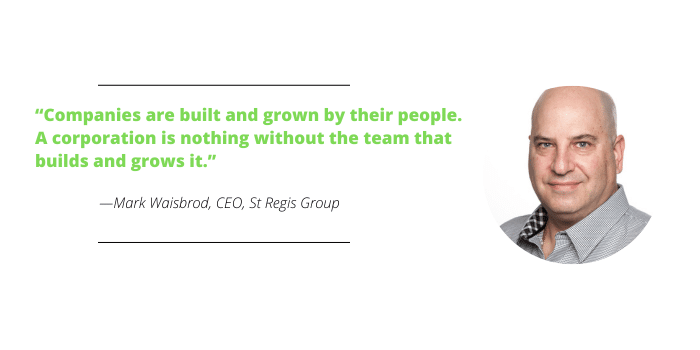
Overseeing several acquisitions while acting as COO of St Regis, Waisbrod says maintaining staffing is critical to a successful transition. “It’s in the interest of all parties to ensure the staff stay with the combined entity to ensure continuity and success for all parties,” Waisbrod says. “Companies are built and grown by their people. A corporation is nothing without the team that builds and grows it.”
In December 2022, St Regis finalized the acquisition, moving Clearmount’s team and operations from Scarborough, Ontario, to its own manufacturing facility in Markham, about 20 minutes away. Two weeks after the sale, Plummer’s father passed away.
“The reason we were able to sell so quickly is because of the work I had been doing for the past five years,” Plummer says. “Transitions are always a five-year project. If you want to sell within the next two years, then you’re three years behind your planning and preparation. Everyone should be preparing for something to happen.”


